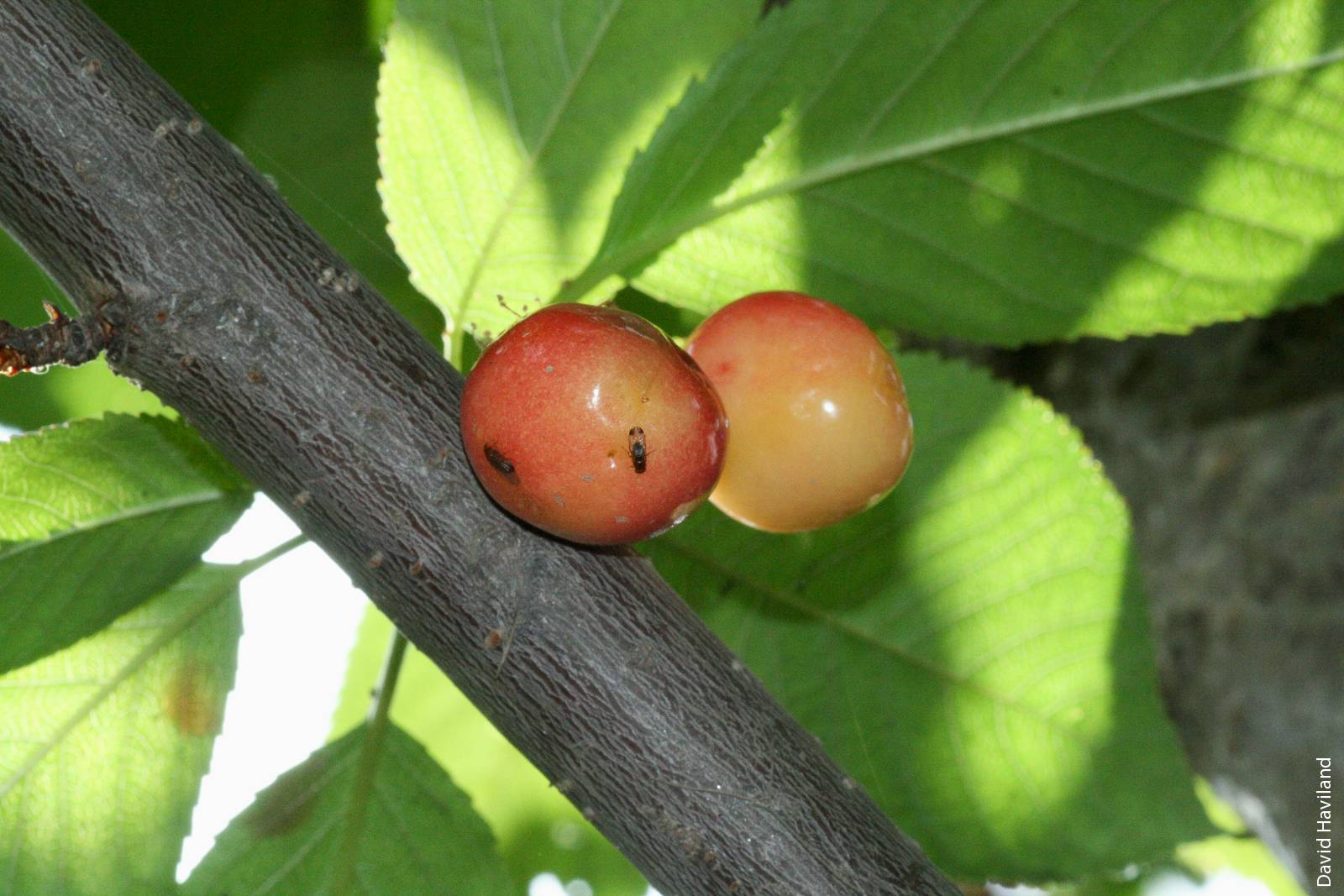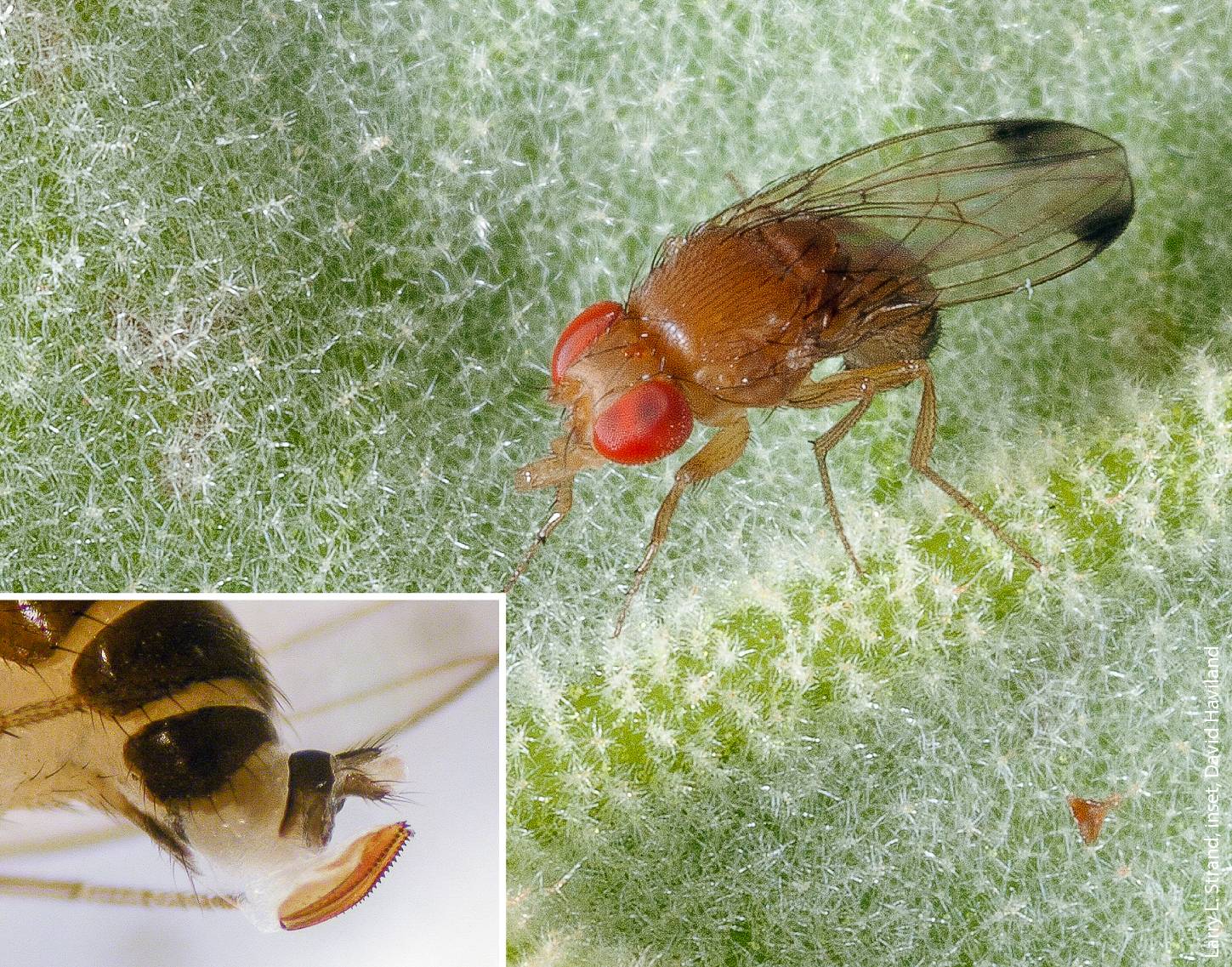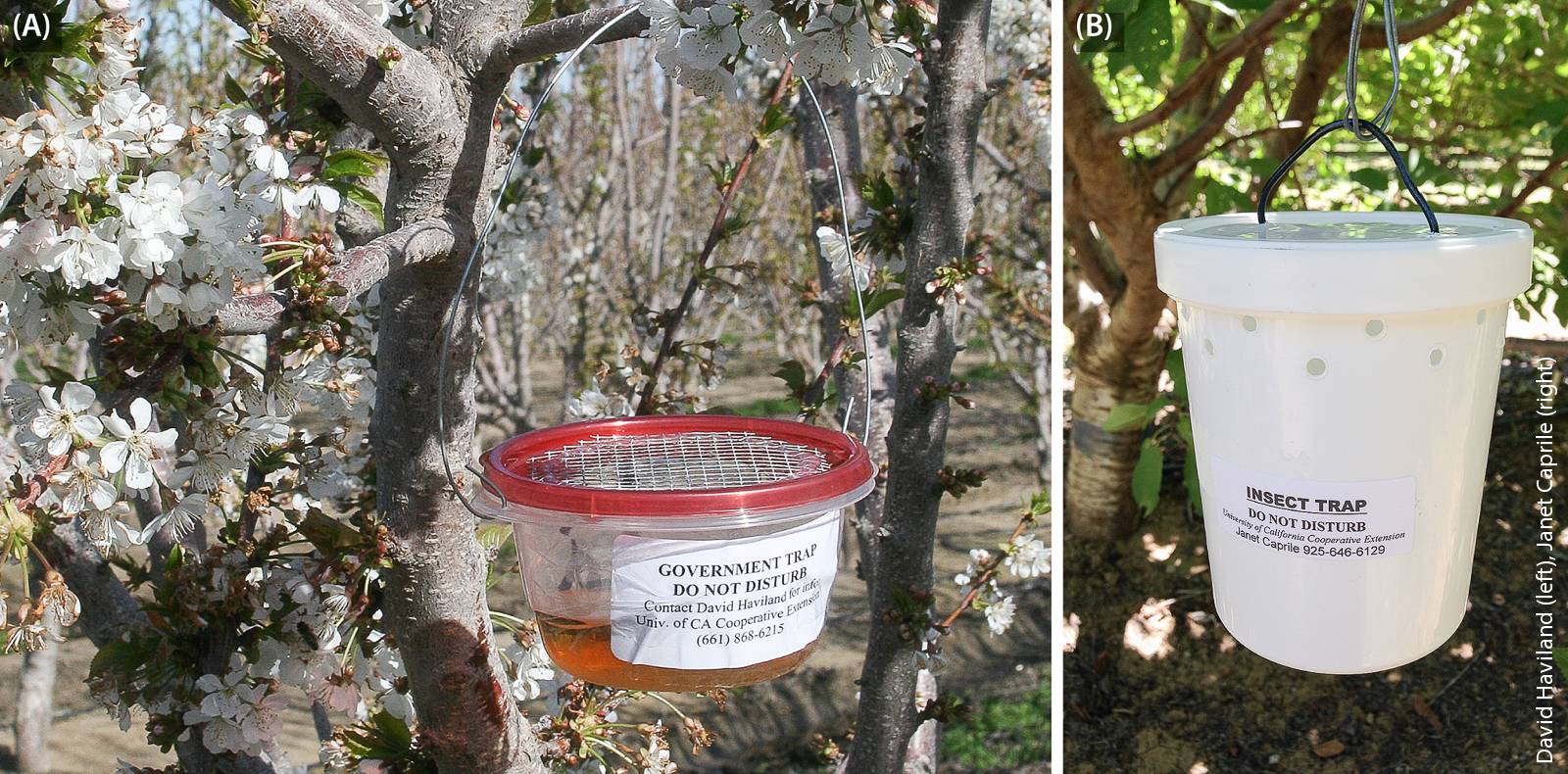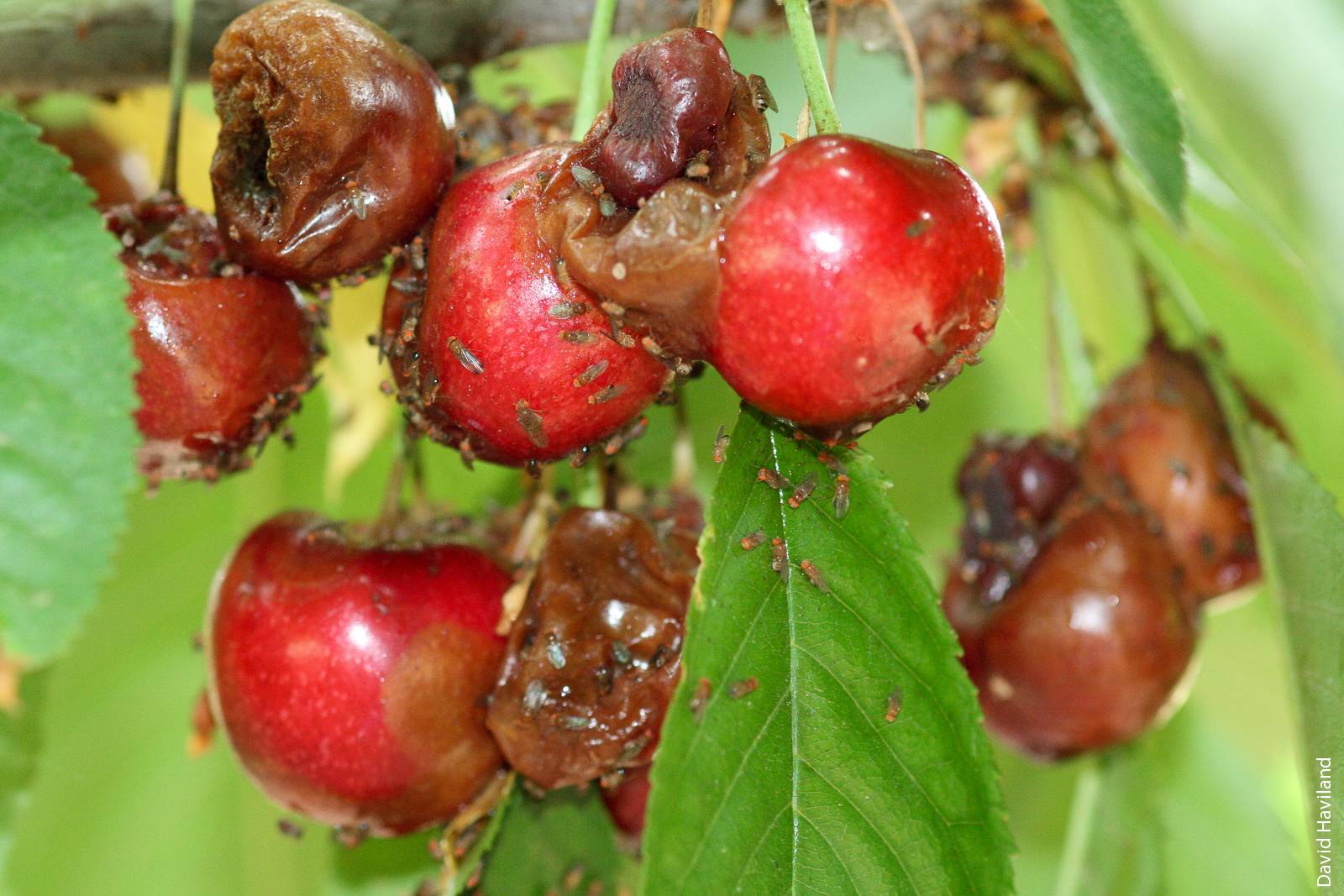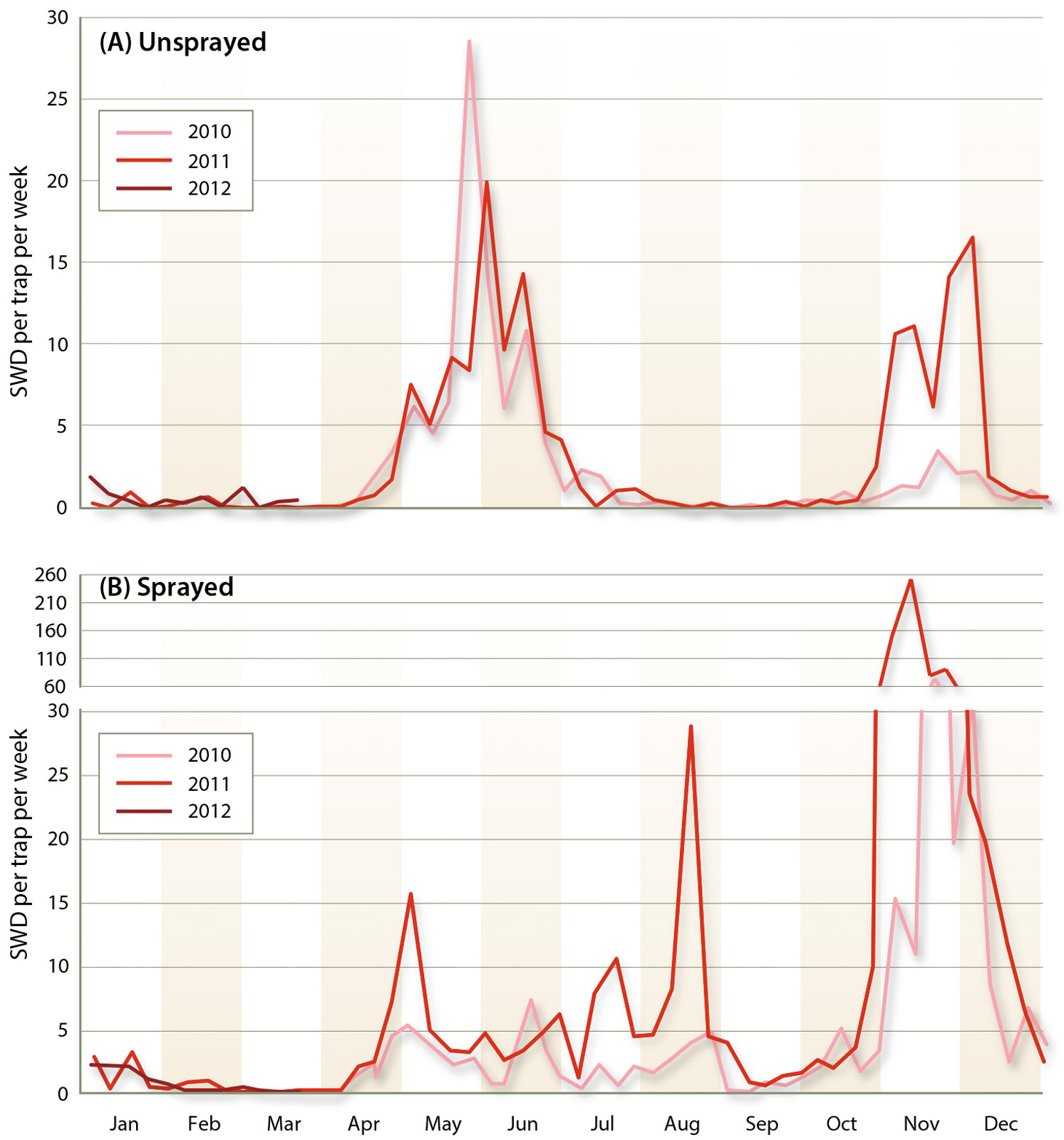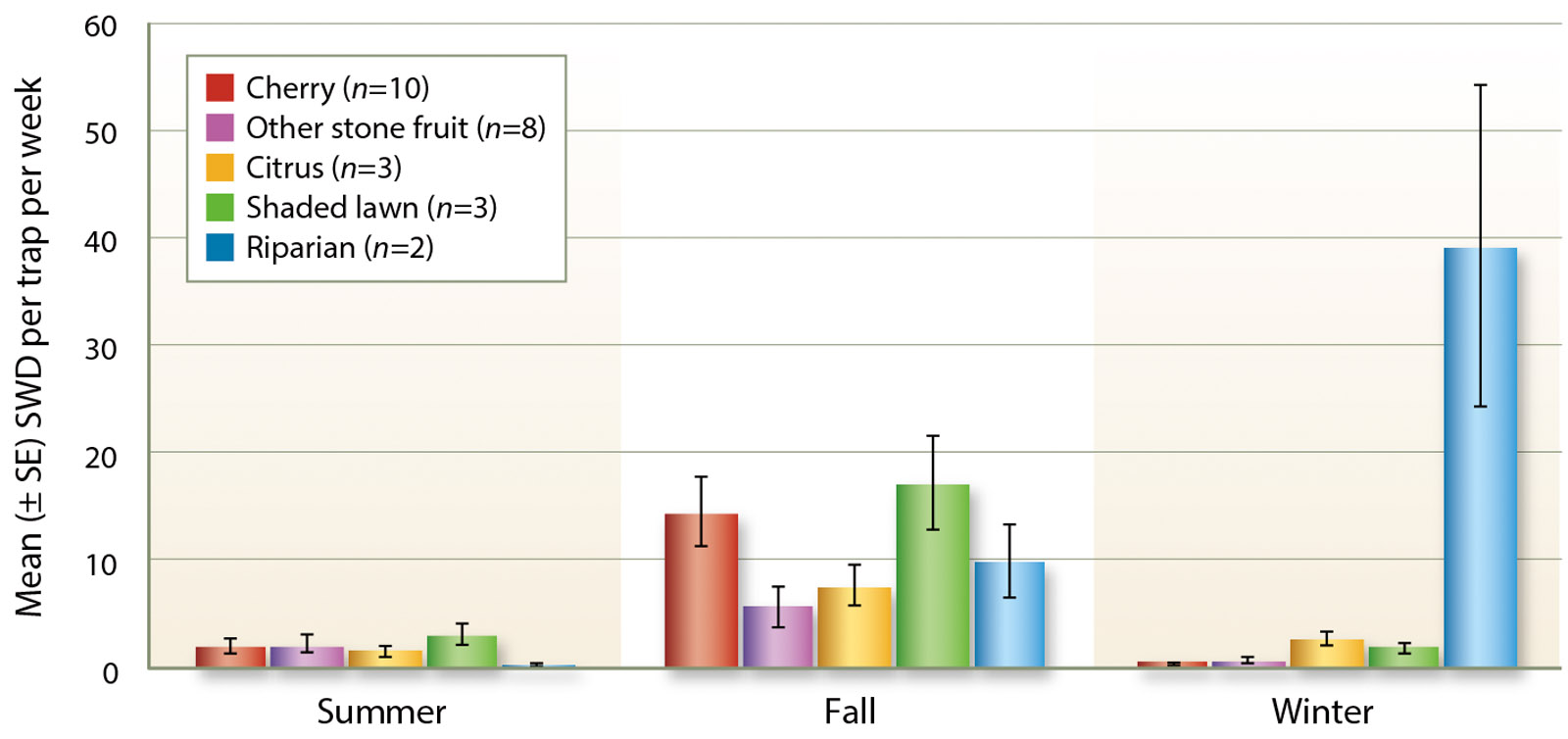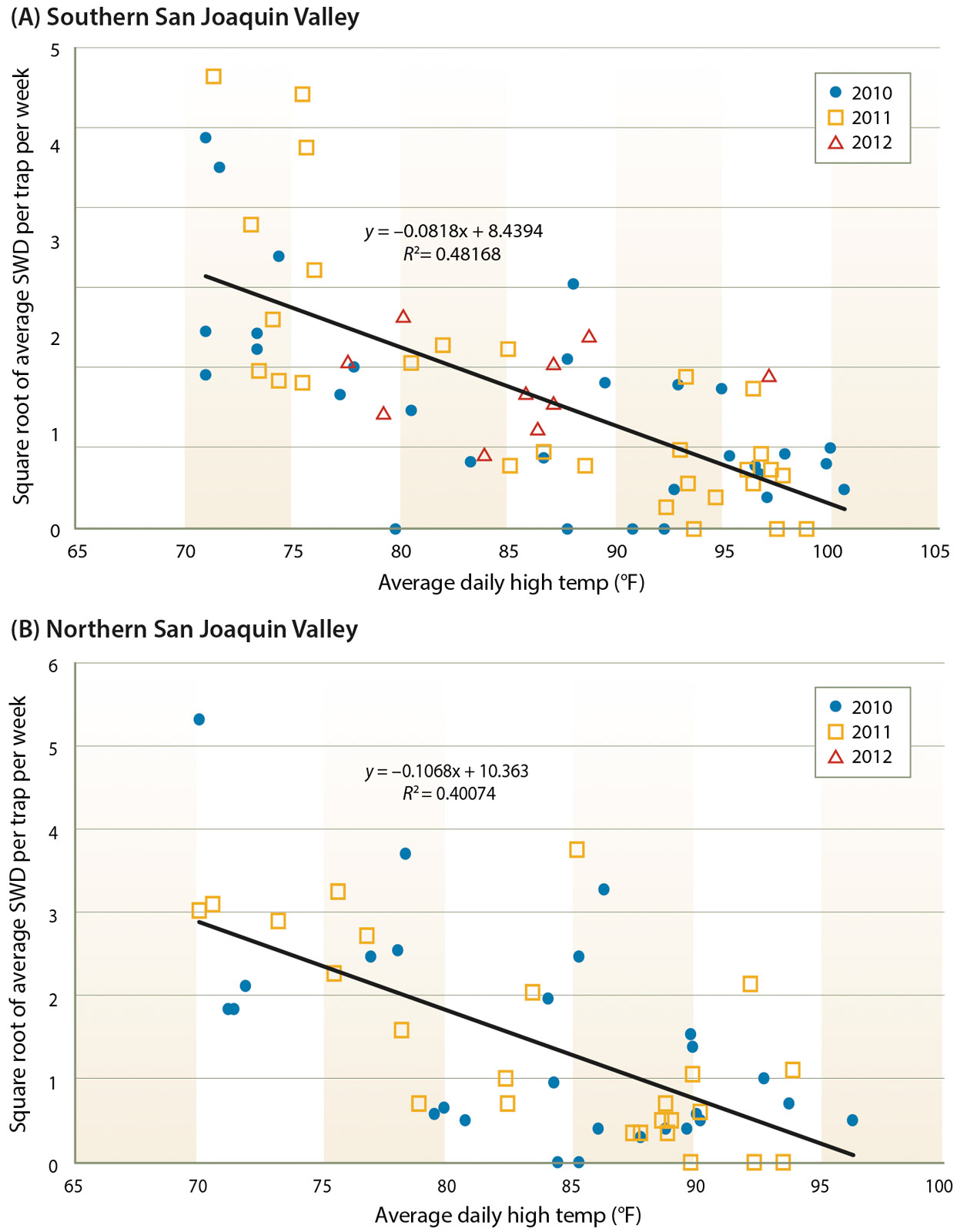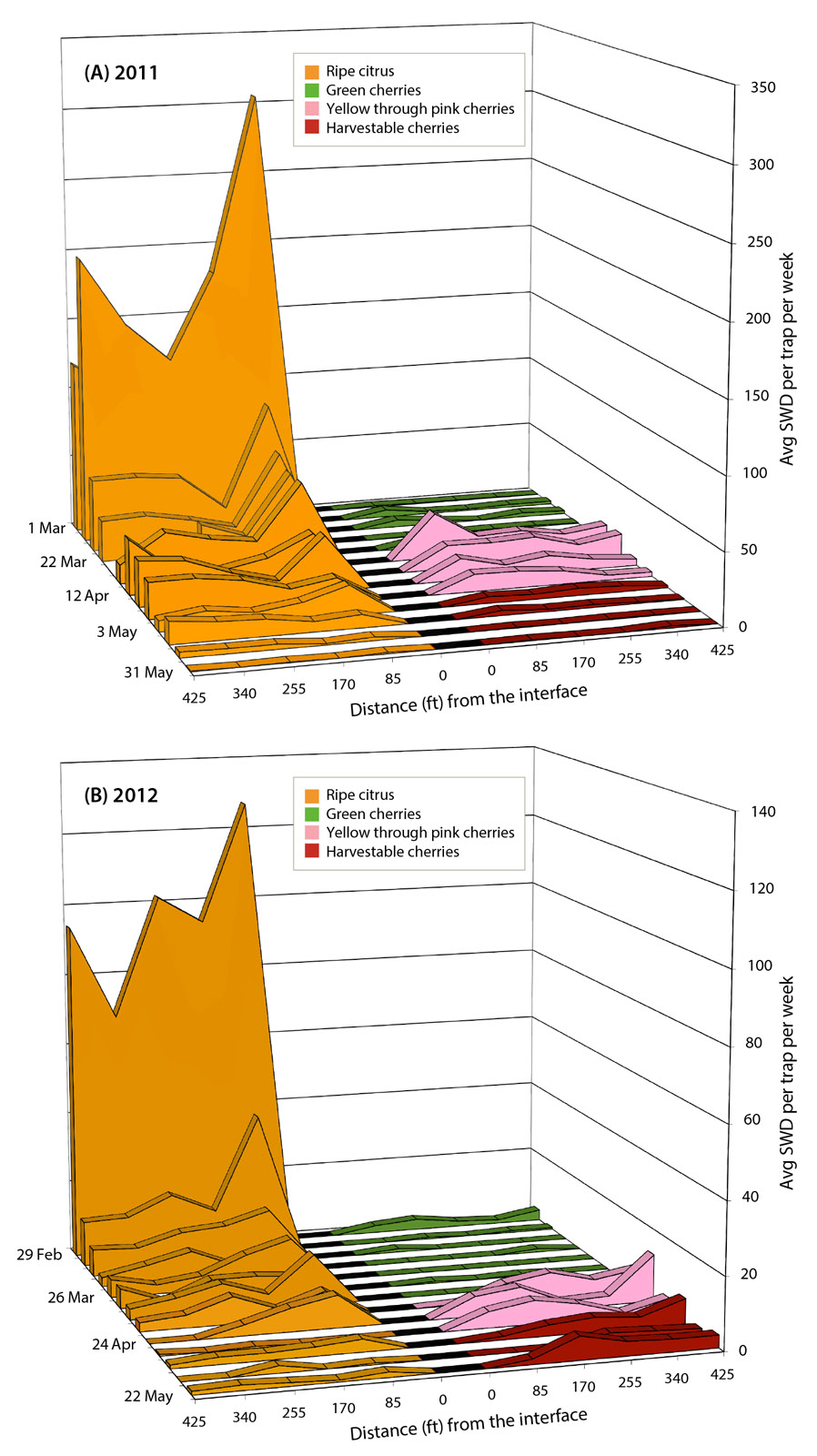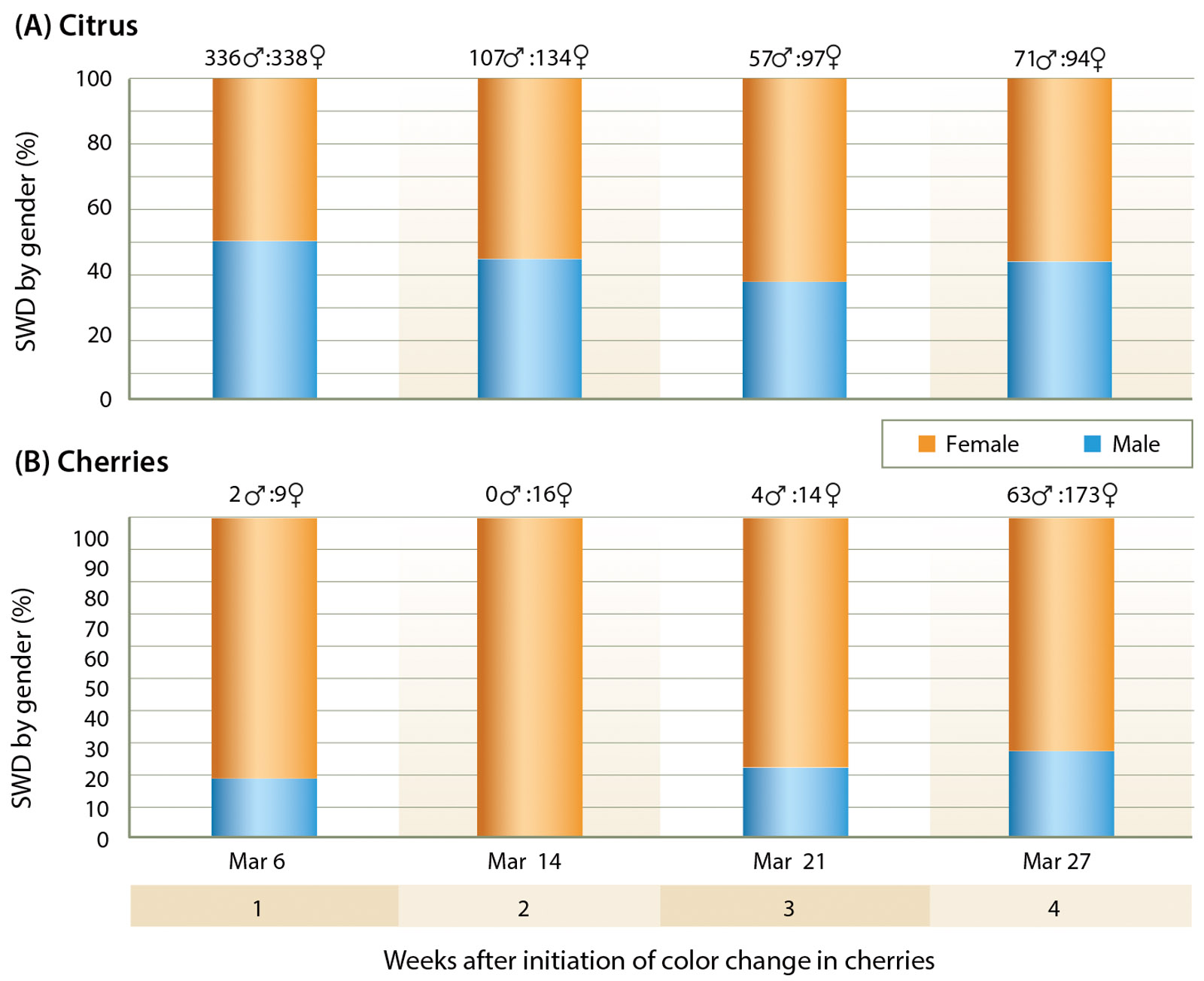All Issues
Phenology of spotted wing drosophila in the San Joaquin Valley varies by season, crop and nearby vegetation
Publication Information
California Agriculture 70(1):24-31. https://doi.org/10.3733/ca.v070n01p24
Published online January 01, 2016
NALT Keywords
Abstract
The spotted wing drosophila, first detected in California in 2008, has become a major insect pest in caneberries and sweet cherries, causing commercial crop losses. Managing it is challenging because it has many other hosts, including riparian and backyard fruit plantings, and it increases rapidly, with generations overlapping one another. In our study we monitored trap captures in two parts of the San Joaquin Valley, within sweet cherry orchards and in nearby locations. Captures of adult flies showed two main periods of activity — spring and fall — and low captures in the winter (except for citrus and evergreen riparian areas) and summer. On many occasions during the year, trap captures were higher outside of the cherry orchards than within them. Additionally, early in the season, when decisions about control programs are being made, the sex ratio of captured flies in cherries was strongly female-biased. The results suggest that during the weeks leading up to harvest growers should experiment by placing traps in different environments surrounding their orchards to determine SWD activity and potential pest pressure locally, and monitor for both male and female flies.
Full text
The spotted wing drosophila (SWD) (Drosophila suzukii [Matsumura]) was first detected in California in 2008 in Santa Cruz County raspberry fields, with subsequent detections in the spring of 2009 in Central Valley cherry orchards (Hauser 2011). SWD is unique among the ?1,500 species of Drosophila flies in its preference for laying eggs in intact, fresh, thin-skinned fruit rather than in damaged, overripe and rotten fruit (Hauser 2011; Walsh et al. 2011). Commercial fruit losses have been reported for blueberries, caneberries, sweet cherries and strawberries in California, Oregon and Washington (Walsh et al. 2011). In California, SWD has become a major insect pest of concern in both caneberries and sweet cherries.
In 2012, there were 31,000 acres of bearing sweet cherries (Prunus avium [L.]) in California with a total value of $258 million (NASS 2012). Most of California commercial sweet cherry production occurs in the Central Valley, where a diversity of other stone fruit, blueberries, citrus crops and grapes are also grown. Additionally, many rural home sites have diverse backyard fruit plantings. This mixed landscape presents a SWD management challenge because ample alternate hosts are available outside the commercial orchards.
Dorsal view of male on leaf, showing a black spot on the tip of each wing (2× magnification). Inset, spotted wing drosophia uses a large, serrated ovipositor to lay eggs in the surface of thin-skinned fruits such as cherries and blueberries.
Not only can SWD use a broad range of resources, but they also develop relatively rapidly. At temperatures between 79°F and 82°F (26°C to 28°C), SWD can complete a generation (from egg to adult) in about 10 days (Tochen et al. 2014). Therefore, populations can build rapidly and generations begin to overlap early in the season, making degree-day models difficult to implement and creating a challenge for monitoring and management (Tochen et al. 2014). The goal of our research was to help growers improve their monitoring and management programs by using the information we collected on the seasonal phenology of SWD within commercial sweet cherry orchards and in nearby locations where they may find food and shelter throughout the year.
Seasonal phenology
Southern San Joaquin Valley.
Adult populations of SWD were monitored weekly from April 5, 2010, to July 2, 2012, at three locations containing commercial plantings of sweet cherries, citrus and blueberries in southeastern Kern County. Each planting was mature and managed using standard production practices for the crop, including SWD insecticide treatments in the cherries. Each of the three locations consisted of all three crops planted so that they shared a common corner. Orchards and fields used in the surveys were a minimum of 20 acres (8 hectares).
For this study we developed a bucket trap for collecting SWD. These traps were made using a 3.2-cup (760 milliliter) plastic container (Rubbermaid, Huntersville, NC) with a 3.3-inch (8.5-centimeter) diameter hole cut in the top and covered with 0.13-inch (0.32-centimeter) wire mesh (hardware cloth). This trap became known as the Haviland trap during early trap evaluation studies (Lee et al. 2012).
Adult SWD were captured using bucket traps containing apple cider vinegar. Wire mesh on top of the trap allowed for the entry of SWD but helped keep out larger insects. (A) Haviland trap, (B) Van Steenwyk trap.
Two bucket traps were used within each crop at each location (total of 18 traps). Each week approximately 5 fluid ounces (150 milliliters) of apple cider vinegar (Amerifoods Trading Co., Los Angeles, CA) was placed into each trap; the traps were hung at a height of approximately 5 feet (1.5 meters) within the tree canopy for cherries and citrus, and on a horizontal wire at a height of approximately 1.5 feet (0.5 meter) for blueberries. After research in 2010 showed that reducing surface tension can improve trap capture, on Jan. 1, 2011, we began adding 1 teaspoon (4 milliliters) of dish soap (Colgate-Palmolive Co., New York, NY) to every 1 gallon (3.78 liters) of apple cider vinegar used in the traps. Each week the contents of each trap were removed from the field and evaluated under magnification in a laboratory by counting the total number of male and female SWD.
Captures of adult SWD in traps showed two main periods of activity — spring and fall — separated by periods of low captures in the winter (except for citrus) and summer. In citrus there were minimal SWD captures from early June through early October, during the hot, dry weather typical of the southern San Joaquin Valley (fig. 1A). The period of fall SWD activity began in mid-October, followed by a rapid increase in captures that peaked in mid- to late November. Captures remained relatively high throughout the winter and tapered off through May and June. In cherries (fig. 1B) there were two periods of SWD activity. The first occurred from March through June and peaked in April just prior to the initiation of insecticide treatments. If insecticides had not been used, it is likely that the peak would have shifted to May, when cherries in Kern County are harvested. The second period of activity was from mid-October to mid-December, peaking in mid- to late November. Very few SWD were captured during the winter, from January through March, or during the summer, from July through September. SWD activity in blueberries in the southern San Joaquin Valley (fig. 1C) had a pattern similar to cherries.
Fig. 1. Seasonal phenology of captures of adult SWD in adjacent (A) citrus, (B) sweet cherry and (C) blueberry plantings in the southern San Joaquin Valley from 2010 to 2012.
Despite similarities in the seasonality of adult SWD activity among the three crops, there were significant differences in SWD abundance. Citrus consistently exhibited the highest trap catches, with fewer catches in cherries and the lowest catches in blueberries (fig. 1). This relationship was consistent in both spring and fall flights even though the cherries were sprayed for SWD in spring (citrus and blueberries were not sprayed); no SWD sprays were applied to any of the crops in fall. As the citrus, cherry and blueberry plantings were adjacent to each other, this trap capture pattern suggests that SWD may have seasonal preferences in where they locate or that traps vary in attractiveness depending on season and crop. Additionally, trap captures did not correlate with fruit presence, especially when considering that peak captures in cherries and blueberries took place in the fall, approximately 6 months after harvest, when no fruit was present.
Both cherries and blueberries are hosts for SWD, and both crops have experienced commercial crop loss in California (Lee et al. 2011; Walsh et al. 2011), though damage to blueberries has been limited to cooler coastal regions; blueberries in the Central Valley have not experienced loss. In contrast, although citrus is not considered a host of SWD due to its thick rind (Atallah et al. 2014), there were high levels of adults captured in citrus orchards throughout their harvest season. In a small, replicated laboratory study (unpublished), Haviland found that SWD did not reproduce on intact or rotting citrus fruit but was able to reproduce on sound, split fruit. So while commercially harvested citrus fruit should not be considered a host of SWD, it is clear that damaged fruit in an orchard can serve as a reproductive host for SWD throughout the winter.
Spotted wing drosophila introduces microbes into cherry fruit before harvest. As fruit begin to rot, they become highly attractive to other drosophila species.
SWD distributions in citrus could also be tied to other food sources that were present in the planting since SWD are known to use some flowers and yeasts as food resources (Hamby et al. 2012; Mitsui et al. 2010). As SWD distribution was measured using an attractant-based trapping system, it is also possible that captures fluctuated due to seasonal variability in the attractiveness of the apple cider vinegar relative to the crop odors or fly activity.
Northern San Joaquin Valley.
Adult populations of SWD were monitored in commercial sweet cherry orchards located near Brentwood in Contra Costa County and Stockton in San Joaquin County. Bucket traps were made using a 1-quart (1-liter), white plastic container that had 16 1/16-inch (4.8-millimeter) holes drilled around the side just below the lid. This trap later became known as the Van Steenwyk trap (Lee et al. 2012). Each week approximately 4 fluid ounces (150 milliliters) of apple cider vinegar (Amerifoods Trading Company, Los Angeles, CA) with 1 to 2 teaspoons (4 to 8 milliliters) of clear, unscented dish soap (Palmolive Pure + Clear) per gallon was placed into each trap, and traps were hung in a shaded portion of the cherry canopy at a height of approximately 5 feet (1.5 meters). Trap contents were collected weekly, and the number of male and female SWD were counted in a laboratory using a dissecting microscope.
In three orchards that were not sprayed for SWD, four traps were placed in each orchard (total of 12 traps) and monitored weekly from mid-March 2010 to March 22, 2012, in two sites and from May 5, 2010, to March 30, 2011, in a third site. In 12 to 14 orchards that were commercially treated for SWD, traps were also deployed from late March 2010 through late March 2012 using one trap per orchard. Additional traps were deployed (one trap per site) in sites surrounding these sprayed cherry orchards from mid-July 2010 through March 2011 to identify other potential hosts and habitats after the cherries had been harvested.
This survey included a wide range of agricultural crops, rural home sites and natural environments. In this report we include only those data that had at least two different trapping locations for the same type of environment and were collected for the entire 8-month period between the 2010 and 2011 spring SWD flights in cherries. The result was a subset of data that included cherries (10 sites), other stone fruit (eight sites), citrus (three sites), irrigated lawns with shade (three sites) and riparian areas (two sites). Data from weekly trap catches were summarized by SWD flight season (summer: mid-July to September; fall: October to December; winter: January to March) and plotted to evaluate differences in SWD density across environments and to visualize changes in distribution patterns throughout the year.
Captures of SWD in unsprayed cherries in the northern San Joaquin Valley (fig. 2A) followed a similar pattern to the southern San Joaquin Valley, with the primary difference being that the spring period of activity occurred slightly later, extending from early April to mid-July, with peak captures approximately 1 week before harvest in late May to early June. Within the northern San Joaquin Valley, comparisons of unsprayed and sprayed orchards (fig. 2) showed that sprayed orchards had lower SWD densities when insecticides were used in May and June, but they had higher SWD densities after harvest in July and August as well as during the fall period of activity, from mid-October to mid-December.
Fig. 2. Phenology of captures of adult SWD in sweet cherries in the northern San Joaquin Valley from 2010 to 2012 in (A) unsprayed orchards and (B) sprayed orchards.
Production of high-quality cherries in California now requires aggressive management programs for spotted wing drosophila.
SWD was found in varying densities in different environments around commercial cherry orchards throughout the year (fig. 3). In summer, fly captures were similarly low in all trap locations. SWD captures increased in fall, with the greatest numbers found in the shaded lawn and cherry environments and modest numbers found in the citrus, stone fruit and riparian sites. In winter, extremely high numbers were found in the riparian sites with evergreen ground or tree cover, but few flies were captured in any other environment. Many insects select special microhabitats to enhance survival during unfavorable conditions (Danks 1978), and during the winter evergreen plants provide additional shelter and favorable microclimates for insects compared with deciduous plants (Johnson et al. 1975). Our data suggest that SWD might choose riparian sites for those reasons. Growers should note that flies are not likely to be detected in their orchards all season long, and placing traps in favorable environments surrounding the orchards in winter to determine the local SWD pressure may be useful as they make their management decisions in spring.
Fig. 3. Average weekly captures of SWD from five different environments surrounding cherry orchards in the northern San Joaquin Valley during the summer, fall and winter SWD flight periods after the 2010 cherry harvest.
High temperature effects on captures.
During all 3 years of study, there were obvious voids in fly captures during the hot and dry summer weather typical of the San Joaquin Valley (figs. 1–3). The relationship between high temperatures and SWD trap captures was evaluated by regressing the average number of SWD collected on each trap collection date in the northern and southern San Joaquin Valley against the average daily high temperature for the week. The x-axis calculations were made using data from weather stations located in Kern County (CIMIS Station #125, Arvin-Edison) and Contra Costa County (CIMIS Station #47, Brentwood). Capture data were square-root transformed (because the data exhibited characteristics of an exponential decay curve as temperatures increased) before a linear correlation analysis was performed for dates where average daily high temperature during the preceding week was at least 70°F (21°C).
Our analyses revealed a significant negative correlation between the average daily high temperature and SWD captures in the southern San Joaquin Valley (fig. 4A) (P < 0.0001, R2 = 0.4817) and in the northern San Joaquin Valley (fig. 4B) (P < 0.0001, R2 = 0.4007). The x-intercept for these two locations suggests that adult captures can still occur when daily high temperatures are in the high 90s and low 100s (°F) (32°C and 38°C). However, captures when daytime temperatures reached 95°F (35°C) were typically less than one SWD per trap per week.
Fig. 4. Regression analysis of the effects of high ambient temperatures on captures of adult SWD in (A) the southern San Joaquin Valley (y = ?0.0818x + 8.4394, R2 = 0.4817) and (B) the northern San Joaquin Valley (y = ?0.1068x + 10.363, R2 = 0.4007). Each point represents the average trap captures (square-root transformed to linearize data) over a period of 1 week compared with the average daily ambient high temperatures during those same weeks from 2010 to 2012.
Other studies have shown similar declines in trap captures as well as reductions in survival and fecundity at high temperatures (David et al. 2005; Kinjo et al. 2014; Tochen et al. 2014). The negative effects of high summer temperatures on SWD may explain why SWD has not become a pest of commercial stone fruit and grapes, which are primarily harvested from July to October in the San Joaquin Valley.
Interface between citrus and cherry
During the springs of 2011 and 2012, we conducted field studies to evaluate patterns of distribution of SWD in citrus and sweet cherries in the southern San Joaquin Valley. Haviland traps were placed in adjacent mature citrus and cherry orchards for a 13-week period comprised of the 10 weeks prior to harvest and the 3 weeks during harvest. Traps were placed in two transect lines, 656 feet (200 meters) apart, that ran perpendicular to the dirt road that served as the interface between the crops. Ten traps were located in each transect, with five located in each crop at 85-foot (26-meter) intervals from the interface. Trap contents were collected weekly and the number of SWD counted. During 2013 the same process was repeated for a 4-week period in March, recording the number of male and female SWD.
SWD captures showed strong variations between citrus and cherries at different times of the year. In 2011 (fig. 5A) and 2012 (fig. 5B), many more SWD were captured in citrus than in cherry while fruit on the cherry trees were still green. This changed approximately 4 weeks prior to harvest as the cherries began to turn from green to yellow and then pink. SWD captures in the cherry orchard with pink fruit were approximately 10 times higher than when fruit were green, despite the fact that the cherry orchards received three insecticide applications for SWD during the pink stage each year. During both years of the study, fly captures during cherry harvest were less than three per trap per week, presumably due to the effectiveness of the repeated insecticide sprays during the pink stages. No SWD damage was found in either year during harvest.
Fig. 5. Weekly SWD captures in transects of traps placed perpendicular to the interface between citrus (left) and cherry (right) orchards from late February to late May in (A) 2011 and (B) 2012. Colors denote fruit ripeness in the orchard (orange indicates ripe citrus, green indicates green cherries, pink indicates first yellow cherry through pink cherry stages, red indicates the presence of harvestable cherries). In both years of the study, cherry orchards were sprayed three times with insecticides for SWD while cherries were in the pink stages.
In 2013 a more detailed analysis of fly captures by gender revealed that sex ratios of SWD in citrus were approximately 50:50 (fig. 6A). However, during the first 3 weeks after cherries become susceptible to attack by SWD (first 3 weeks in March), only 13.3% of the flies captured were male; during the fourth week only 27% were male (fig. 6B). A similar pattern of female dominance was seen in cherry orchards in the northern San Joaquin Valley during the spring SWD flight period (data not presented). This pattern suggests that cherry growers should not rely on the more easily detectable male captures in traps but need to use magnification to identify the females in order to accurately gauge SWD abundance in spring, the critical time for making management decisions.
Fig. 6. Male-to-female ratios of SWD collected in (A) citrus and (B) cherries from late February when cherries are green through late March when cherries begin to change color and become susceptible to attack by SWD in the southern San Joaquin Valley.
Management implications
Our study presents important considerations for SWD monitoring programs, including seasonal patterns in trap captures, trapping protocols, climatic factors and the influence of the local landscape, that can be used in integrated pest management (IPM) programs for SWD. In some cases, such as stone fruit, peaches and nectarines, SWD management has not been needed because fruit are harvested during periods of the summer when our data show that adult SWD are not active. The opposite is true for cherries; phenology data confirm the presence of elevated SWD populations during the period of early color change through harvest, when cherries are susceptible to attack (Lee et al. 2011). The current standard practice in cherries is to control SWD with two or three insecticide applications during the 3 to 4 weeks prior to harvest (Haviland and Beers 2012). The decision whether to use two or to use three applications can be assisted by the use of traps. However, our data suggest that bucket traps baited with apple cider vinegar are likely to lead to false conclusions about SWD density unless both males and females are counted. If cherry orchards are located near commercial citrus or other favorable SWD overwintering sites, traps should also be placed in those environments to get a more accurate picture of the regional SWD pressure.
We anticipate that increased knowledge about SWD population changes throughout the year and movement among crops will lead to improvements in the ability of pest control advisers and growers in California to anticipate locations where problems with SWD may occur and to make site-specific decisions about the integrated pest management programs they use to protect their crops.



